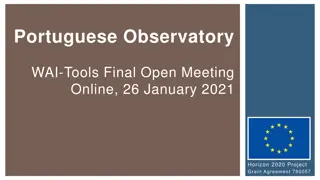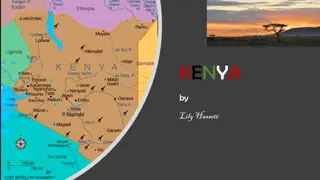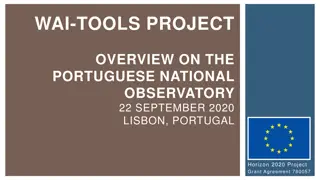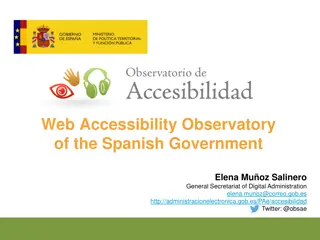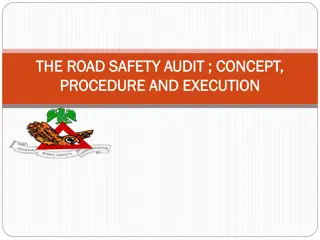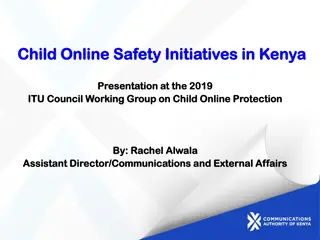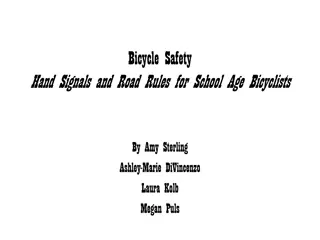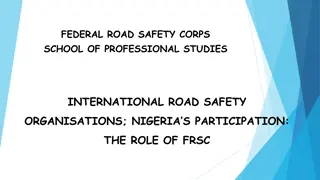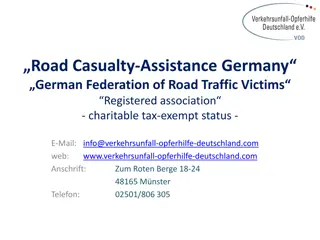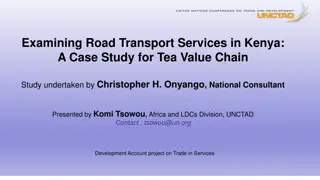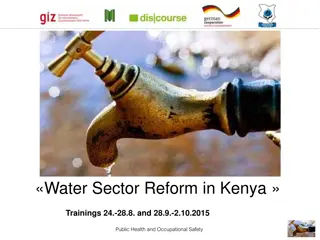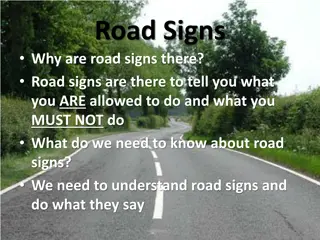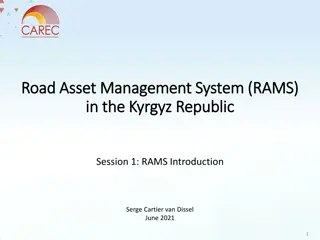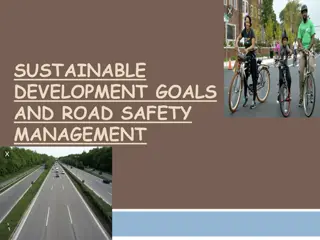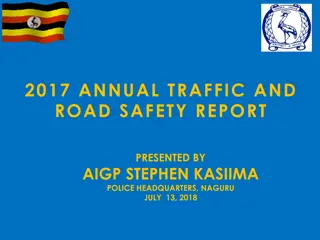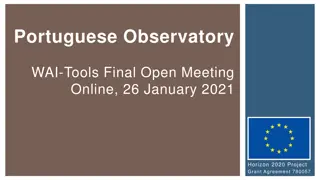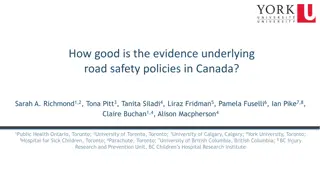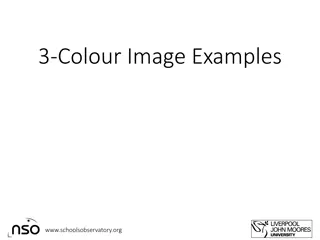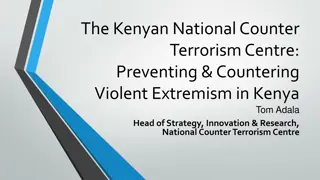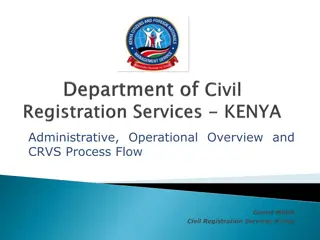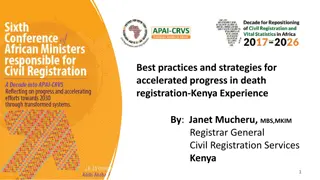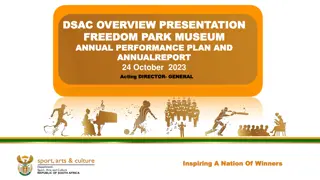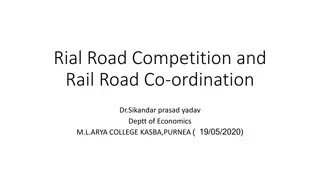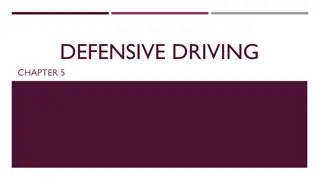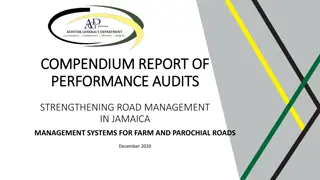Road Safety Observatory in Kenya: Expectations and Mandate
Kenya aims to establish a Road Safety Observatory to enhance the road transport system's efficiency and safety. The National Transport and Safety Authority (NTSA) plays a crucial role in advising, implementing policies, and regulating the road transport sector to ensure safe and reliable transportation services. NTSA functions include vehicle registration, inspection, driver training, and policy advice to the government. The Vision and Mission of the NTSA focus on improving accessibility and safety for all road users in Kenya.
Download Presentation

Please find below an Image/Link to download the presentation.
The content on the website is provided AS IS for your information and personal use only. It may not be sold, licensed, or shared on other websites without obtaining consent from the author. Download presentation by click this link. If you encounter any issues during the download, it is possible that the publisher has removed the file from their server.
E N D
Presentation Transcript
KENYAS EXPECTATION OF ROAD SAFETY OBSERVATORY TOWARDS THE ESTABLISHMENT OF ROAD SAFETY OBSERVATORY IN KENYA 20THFEBRUARY, 2018 DR DUNCAN KIBOGONG
Africa KENYA
Kenya South Sudan Ethiopia Uganda Somalia Tanzania Indian Ocean
Kenya East African Country 2015 Population of 47.8* Surface area:582,650 km Number of registered vehicles (2016): 2,758,731b * Kenya National Bureau of Statistics Projections/World Bank Report bNational Transport and Safety Authority (NTSA)
VISION & MISSION VISION & MISSION Vision Efficient, Reliable and Safe Road Transport System in Kenya Mission To continually improve accessibility and safety of Kenya s road transport system for all users
OUR MANDATE To advise and make recommendations on matters relating to road transport and safety To Implement policies relating to road transport and safety To plan, manage and regulate the road transport sector in accordance with the provisions of the NTSA Act no.33, 2012 To ensure the provision of safe, reliable and efficient road transport service
NTSA functions In performance of its functions, the Authority is mandated to:- register and license motor vehicles, conduct motor vehicle inspection and certification, regulate public service vehicles, advise the Government on national policy with regard to road transport sector, develop and implement road safety strategies, facilitate the education of members of the public on road safety, conduct research and audits on road safety, compile inspection reports relating to traffic accidents, establish systems and procedures for, and oversee the training, testing and licensing of drivers, formulate and review the curriculum of driving schools, and Coordinate the activities of persons and organizations dealing in matters relating to road safety. Perform such other functions as may be conferred on it by the Cabinet Secretary or by any other written Law
NTSA The Sessional Paper Number 2 of 2012 on Integrated National Transport Policy identified disjointed and weak institutional framework as one of the challenges experienced in management of the road transport subsector in Kenya This disjointedness contributed to unsafe, unreliable and inefficient road transport systems in Kenya The UN Decade of Global Action plan in pillar 1( Road Safety Management) recommend the setting up of a lead agency
Road crash data systems Introduction NTSA s Action Plan 2015-2020 is developed with this consideration in the thematic areas of: I. Road Crash Data System whose objective is To establish, support and implement road safety data systems that supports generation of evidence based policy formulation and implementation and for robust monitoring and evaluation of the action plan II. Road Safety Research whose objective is To regularly conduct research on road safety issues, analyze data and input into decision making processes to make effective and appropriate road safety interventions
DATA IMPROVEMENT SINCE NTSA INCEPTION There s general improvement of data since NTSA inceptions Initially road safety statistics were just about an absolute figure and other parameters were not being measured Currently data is analyzed to inform decision making to a larger extend compared to what was existing before More refined data has enable NTSA to have data led road safety interventions with some commendable level of success But there is a lot to be improved to generate more refined data for evidence based road safety policies and interventions
Better Data by in Kenya NTSA inception Detailed road crash data is available on: The road user type involved in rash The vehicle type Distribution across the time of the day Distribution across the week Distribution across the year Distribution across the counties Distribution across age groups Distribution on Gender/sex The roads crashes happen esp in the The causes of crashes-through cause codes
KENYA STRENGTH ON TIMS KENYA STRENGTH ON TIMS NTSA has established the Transport Integrated Management Systems (TIMS), which serves as the central database and platform for managing driver licensing, motor vehicle inspections, vehicle registration and PSV management in Kenya. Transport Integrated Managements Systems (TIMS) to enhance efficiency and increased reliability of data The TIMS helps in the management of the following information: Vehicle registration data Motor vehicle inspection data Statistics on traffic violations Road service licences for public transport Driving license data This provide exposure data
TIMS Some Online-Services in the TIMS platform Motor Vehicle Registration and Licencing(Transfers, duplicate logbooks) Motor Vehicle Inspection Self-booking Application of Provisional Driving License Booking for a Driving Test Interim Drivers License Duplicate Driving License Endorsement of additional Classes Renewal of Drivers License (1 yr and 3yrs) Amendment of Drivers License Details Drivers PSV license Conductors PSV license Road Service License Mobile policing Device/Gadget Verification of genuine NTSA documents using SMS code
Data Sources in Kenya Data Sources in Kenya Data is available in the following Police, Health Institution Vital registration Department Insurance companies, Insurance regulatory Authority, Ambulance Records NTSA Research Institutions/universities, Private Road Transport Companies Most of the data available for use currently is from the traffic department.
POLICE DATA POLICE DATA The police data, which is the main source, has the following attributes: STRENGTHS: It is national in terms of coverage Collect most of the important data elements Available on daily basis Raw data and can be analyzed in whichever format you want WEAKNESSES Most of the information derived from this data source is fatal injuries There is no electronic linkages with the other data sources The data is provided in raw absolute formats and not in tabulated or other customized specifications Demonstrates a weak link to other systems for follow up of injuries Definitions on the severity of injury by the police is not standardizes as per the international standard. In any case Kenyan police aren t trained to differentiate the same.
VITAL STATISTICS VITAL STATISTICS Vital Statistics is a data source in Kenya coverage currently standing at 50% Completeness Missing data on death certificates; Misclassification of cause of death doctors must be sufficiently trained to record and code correctly the underlying cause of death; Inadequate coding NTSA together with the registration of deaths department is working to regularly get this data and further link the two institutions
Health facility data Health facility data Health facility data advantage is it picks on the burden and severity of RTIs Some challenges on this include: People with minor injuries not seeking formal medical care; Poor access to health facilities; Injuries treated at private hospitals remaining unrecorded, as non- government Lack of training, expertise, interest or time on the part of health workers, who may not record all relevant details of the injury; Data being incorrectly coded by the health worker, or by the person responsible for data extraction or data entry.
Exposure Data Exposure Data EXPOSURE DATA AVAILABLE The TIMS helps in the management of the following information: Vehicle registration data Motor vehicle inspection data Statistics on traffic violations Road service licences for public transport Driving license data Road layout, design and environment; Available with the road Authorities The demographics of the county/county This information is available from secondary sources-National Census, KNBS, KDHS EXPOSURE DATA WEAKNESS Traffic flows and characteristics/traffic volume data May require a study or Intelligent Transport Systems/ITS which will pick the information real-time. 1. 2. 3. 4.
Cooperation and Collaboration Kenya is cooperates with a number of African Countries through a number of regional integrations. Some of these blocks on standardization of road transport and road safety protocols including Motor vehicle inspections, driving School Curriculums among other road transport and safety themes These include; East African Community-Kenya, Uganda, Tanzania, South Sudan, Rwanda, Burudi Northern Corridor Integration Projects-Kenya, Uganda, Rwanda,South Sudan ,DRC IGAD- AU Commission African Road Safety Observatory can be leveraged on this regional integration
Expectation The observatory be set Standardization of Minimum data elements to be collected (road related ,crash related, vehicle related and person/road user related) The data sources as a minimum include data from the police, health and Vital statistics Fatal and Injury severity data be collected Definition of a fatal injury be standardized Definition of injury be standardized Exposure data to be collected form the participating countries be standardized Safety performance Indicators be standardized across countries
Expectation That the data be analyzed as soon as collected The data is analyzed and standard template for reporting Data be shared with each country fro approval before dissemination via the observatory s portal The participating countries to agree on the period need to seek approvals before dissemination of the analyzed data/report The periodicity of the report be every 6 months The participating countries to have annual meeting to discuss the data and issues appertaining to the observatory. Efforts be made towards measuring the costs of crashes as capacities improve That the observatory becomes an avenue of information sharing of best practice etc
Main Actors of the Observatory State Agencies and Institutions: Ministry of Transport and Infrastructure Mistry of Health National Transport and Safety Authority The Traffic Police Department of Civil Registration Kenya national Bureau of Statistics Road Authorities Insurance Regulatory Authority Universities and Research Institutions
Main Actors of the Observatory International Actors; World Bank SSATP African Development Bank European Union WHO UN agencies UNON Regional Integration Blocs


